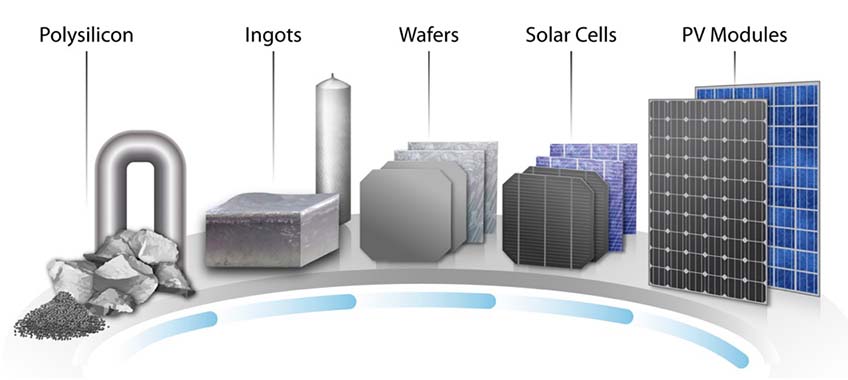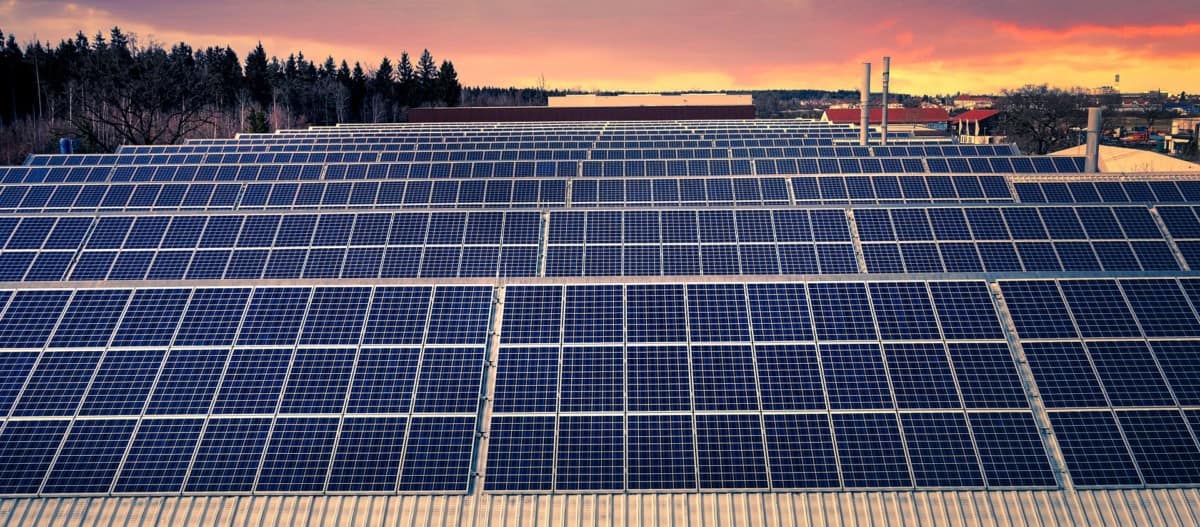What is a Solar Panel Made Of?
Most solar panels are normally made of silicon. This is a natural component that’s found in beach sand. The Silicon element has atomic number 14 on the periodic table. Although it’s a nonmetal, it features conducive element properties that make it effective to convert sun rays into electricity.
Light usually reacts with silicon cells, resulting in the motion of the electrons. This is what usually facilitates the flow of electricity. Overall, Silicon is abundant and readily available and that’s why it’s rated as the 2nd most available element on this planet.
While this material is readily available, the conversion process is usually demanding. Besides that, making high-grade silicon usually requires intense use of energy. As a result, the cost of silicon material is usually higher.
What are Solar Panels Made Of?
Manufacturing of Solar Panels
Now that you know what is a solar panel made of, it’s critical that you understand the manufacturing process. The whole process involves the production of various components of the solar panels. For starters, a solar PV consists of:
- Glass
- Solar cells
- Backsheet
- Ethylene Vinyl Acetate (EVA) and frame
Looking at the cell structure level, there are three types of solar panels. They are made of different materials which means that the manufacturing process is slightly different.
- Monocrystalline solar panels
- Polycrystalline solar panels
- Thin solar panels
Both monocrystalline and polycrystalline solar panels are made using the same manufacturing process. To understand their manufacturing process, below is an overview highlighting how is a solar panel made.
Sand conversion
Like it’s stated above, sand is the main raw material that’s used to make silicon. You can easily find it in natural beach sand. The silica sand, also known as silicon dioxide, undergoes processing in order to remove oxygen, leaving silicon back.
The whole process requires mixing silica sand by first mixing it with carbon and then heating it at high temperatures in an electric arc furnace. These temperatures usually go beyond 2,000 degrees Celsius.
Solar Ingots
Ingots are also raw materials that are used to make solar cells. They are critical in the first step of making a panel, especially the solar wafers that are used to make the base of the solar panels.
Once impurities have been removed from the silicon extract, it’s then turned into ingots. These are simply pure silicon cylinders.
Solar ingots are made after dipping crystal silicon into polycrystalline silicon. So, all the remaining impurities will be melted in liquid. The end result is a completely pure ingot cylinder.
Understand that silicon raw material is usually collected in the form of solid rocks. So, they have to be melted together at extremely high temperatures before they can be molded to form cylindrical ingots.
In order to attain the shape of the cylinder, the manufacturer has to use a steel and cylindrical-shaped furnace. This is the most intense process of making solar panels. The manufacturer has to pay more attention to the molten silicon to ensure that the resulting cylinder has well-aligned atoms that suit the design and orientation of ingots.
In order to create a silicon material with positive electrical polarity, Boron has to be added during the melting process. To make monocrystalline solar panel cells, the manufacturer has to simply use a single silicon crystal. Polycrystalline solar panel cells need multiple silicon crystals.
Polycrystalline panels have a shattered glass appearance and this is due to the presence of multiple different types of silicon crystals.
However, monocrystalline cells usually provide users with a higher level of efficiency. This is because their design makes them more effective in converting solar energy to electricity. That’s why the cost of these panels is usually higher than that of their polycrystalline counterparts.
To create ingots of high quality, the cylinders have to undergo a cooling process. Thereafter, they will get grounded and polished to create ingots that have flat sides.
Wafer Design
Wafers are simply thinly sliced silicon ingots with disk shapes. Their design process usually happens right after the formation of polished and ground ingots with flat sides.
Manufacturers use sharp wire saws with a high level of precision to slice the ingots. The disks formed are normally as thin, almost as thick as a piece of paper.
For efficiency, the wafers have to be coated with anti-reflective materials. This is because pure silicon in its original state is shiny and highly reflective. The coating process is essential in reducing the amount of energy lost once the sun rays hit the panel.
Formation of the Solar Cells
So, you now have wafers. Well, these are the raw materials that will be used to make the solar cells responsible for generating solar electricity.
The manufacturing process at this stage involves treating wafers. Besides that, metal conductors have to be added to each surface of the wafers, resulting in a grid-like matrix. This will enhance the process of solar energy conversion into electricity. Meanwhile, the coating will further enhance sunlight absorption, making the whole process effective.
To complete the formation of the solar cells, the wafers have to place in an oven-like chamber. Phosphorus will then be diffused to cover the layer of the wafers, creating a negative electrical orientation. Remember that boron was added to create a positive orientation.
So, a combination of phosphorus and boron will help to create the positive-negative electrical junction that’s important for the effective functioning of a normal PV cell.

Soldering of the Solar Cells
Solar panels feature numerous solar cells. To complete the formation process, the cells have to be soldered together. This process usually involves the use of metal connectors to connect the cells. The eventual product is something that has a matrix-like structure.
It should be noted that the number of cells determines the size of the solar panel and where it should be used. For instance:
- A 72-cell panel is ideal for large-scale installation
- A 60-cell panel is considered to be the standard size
- A 48-cell panel is ideal for residential use due to its small size
Installation of Protective Covers
The joined cells can’t be left uncovered since they would be susceptible to damage from elements of weather and other objects.
For improved protection and enhanced durability, a thin glass layer, usually measuring 6-7 mm, is added on the front/top side of the panel. It’s essential that a thin glass is used for transparency and better solar energy conversion. Note that an opaque material can’t be used since it will block all the sun’s rays.
On the other hand, a highly durable material, mostly poly-based, is placed on the backside. This is essential in ensuring water, dust, and other types of debris are inhibited from entering the panels from the backside. To make connections inside the module, a junction box is installed.
Lastly, a frame is installed to enhance the durability and portability of the panel. This is critical in ensuring that the panel can not only withstand the harsh elements of weather but also heavy impact.
Besides that, this frame helps to facilitate the installation process on different surfaces or objects. For instance, you can use it to mount clamps on the panel.
Note: at this point, everything will be joined using EVA
Manufacturing Thin Film Solar Panels
The process is quite different in this case. Manufacturers tend to use thin films of semiconductors that are then deposited on glass, metal, or plastic. It’s worth noting that the films are extremely thin, in fact, almost 20x thinner than the standard wafers.
While they are lightweight in nature and more flexible, thin-film solar panels are not more popular since they have low efficiency. You need to install more panels to get a sufficient amount of electrical energy. In addition to that, the manufacturing process is quite demanding and they have higher installation costs.
The process of manufacturing solar panels has now come to an end. But to ensure that the products released to the market are functional and efficient, standard test procedures have to be too conducted. The basics can be read at energy.gov
Standard Testing
Standard Test Conditions (STC) are used as the reference point to carry out module testing. While the panels are still in the manufacturing facility, they have to be put in flash testers. Most of these testers have 1.5g air mass, 25 degrees Celsius temperature, and almost 1000W/M² irradiance.
Technical specifications of the panels will be analyzed and important ratings such as temperature tolerance, efficiency, power output, voltage, current, and impact tolerance will be written down. A functional panel needs to have specifications that are almost similar to real-life scenarios.
Generally, panels subjected to STC tests should be able to at least deliver the following parameters:
- 1 m/s wind speed
- 20 degrees Celsius ambient temperature
- 800W/M² irradiance
Takeaway
From the extraction of silicon-oxygen to testing, the process of making solar panels is quite demanding. Everything has to be done with a high level of precision to ensure that the end product can effectively absorb sun rays and then convert them to energy. Most manufacturers tend to make monocrystalline and polycrystalline solar panels since they are efficient and offer value for money.
Recent Posts
Understanding Energy and Electricity: The Power For Progress
Energy and Electricity Energy and electricity are integral components of modern life, powering everything from homes and businesses to transportation and communication. Without them, the...
The Future of Wind Energy The future of wind energy is set to play a critical role in addressing global energy needs while combating climate change. As renewable energy sources like wind and...


